|
Thursday, Dec. 5
- Breakfast: Canadian bacon, egg and cheese Texas toast
- Breakfast: Greek omelet
- Ranch house steak sandwich
- Asian beef and vegetables
- Chicken cacciatore
- Italian loaf sandwich
- Tex-Mex grilled-chicken salad
- Chicken noodle soup
- Chef's choice soup
Wilson Hall Cafe menu |
|
Friday, Dec. 6
Dinner
- Mussels in white wine and thyme
- Medallions of beef
- Sour cream and chive mashed potatoes
- Haricots verts
- Chocolate pots de crème
Wednesday, Dec. 11
Lunch
- Stuffed cabbage
- Mashed potatoes
- German chocolate cake
Chez Leon menu
Call x3524 to make your reservation.
|
|
Explain it in 60 seconds: baryonic acoustic oscillations
 |
Scientists have found a way to study sound waves from the early universe to learn more about its history and contents. Image: Sandbox Studio
|
Baryonic acoustic oscillations are sound waves from the early universe. Scientists have found a way to study these sound waves to learn more about the universe's history and contents. Shortly after the big bang, when the universe was hot and dense, regions with greater concentrations of light and matter had higher pressure than others. Acoustic waves — governed by the same laws of physics that describe how sound travels to our ears — rippled outward from those high-pressure regions.
These waves carried ordinary (or "baryonic") matter with them until the universe cooled enough for light to be able to travel freely. Theoretical calculations predicted that a faint imprint of their pattern should remain in the distribution of all the matter we see in the universe today.
In recent years, researchers have identified the distinctive pattern of these sound waves in maps of distant galaxies. The waves have a very well-understood size, about 500 million light years across. Looking at ever more distant galaxies and peering back in time, scientists can measure the angle of these waves on the sky. Simple geometry then determines how the universe itself has grown.
This method has provided important tests of the nature of dark energy, which is the dominant component of the universe today yet remains poorly understood. Scientists are currently planning new experiments that will measure the universe's growth with unprecedented accuracy by exploiting these sound waves from the dawn of time.
—Jeffrey Newman, University of Pittsburgh
Read similar explanations in the symmetry archive
|
Subscribe to Fermilab's new community newsletter
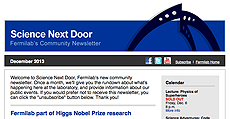 |
The first issue of the new Science Next Door community newsletter came out this week.
|
This week, Fermilab rolled out a new way for our neighbors to find out what's happening here at the laboratory. Our new monthly email newsletter, Science Next Door, features information on public events held at the lab — lectures, tours, volunteer opportunities — in one free, easy-to-read package. Check out the first issue here. Subscribe to get it every month here.
|
Clinging to a cloud
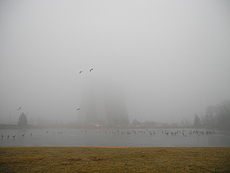 |
| Tuesday's dense fog covered lab grounds like a blanket. Photo: Rick Meaderdes, BSS |
|
Fermilab Arts and Lecture Series box office moves to Wilson Hall mezzanine
The Fermilab Arts and Lecture Series box office relocates to the Wilson Hall mezzanine today. This is a change in the previous plan to move it to the 15th floor.
To contact the box office, call 630-840-2787 or email audweb@fnal.gov. If you have questions or concerns about the move or about how to find our new location on the mezzanine, please contact Amanda Thompson at 630-840-4203.
|
Hints of cold dark matter pop up in 10-year-old circuit
From New Scientist, Dec. 3, 2013
Oops. One of the universe's most-wanted particles may have shown its face in a simple tabletop experiment nearly a decade ago — only no one noticed at the time.
"If other experiments confirm the effect, then it could be an immense step forward in our understanding of the matter contents of the universe," says Christian Beck of Queen Mary, University of London, UK.
Beck has reanalysed an unexplained signal in an electrical circuit, first reported in 2004, and says it is just what you would expect to see if dark matter takes the form of hypothetical particles called axions. It's too soon to known if the signal actually is dark matter, but these circuits — Josephson junctions — may present a promising new way to hunt for the mysterious stuff.
Read more
|
High-performance computing clears up big bang chemical conundrum
From iSGTW, Dec. 4, 2013
For roughly two decades, scientists have struggled to understand the ratio of lithium isotopes found within the bellies of the oldest stars in the universe. Now, with the aid of high-performance computing, an international group of researchers has put this cosmic problem to rest.
The team, with researchers based in Australia, Brazil, Germany, and the UK, has matched observation with theory, providing a better understanding of what happened just after the big bang, 13.8 billion years ago. To reach this solution, it took some creative thinking, starlight, and a 3D model working in parallel on supercomputing hardware at the Max Planck Institute for Astrophysics in Garching, Germany. The team published their research earlier this year in the journal Astronomy and Astrophysics.
Read more
|
|
Flipping a coin to help measure charge asymmetries
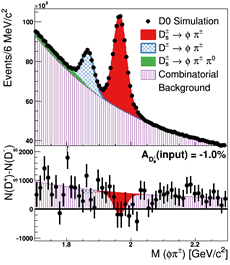 |
| The top figure is the invariant mass distribution of all Ds± meson candidates, with a clear signal peak shown in red, together with a number of background processes. For the lower figure, each point is the difference between the number of positive (Ds+) and negative (Ds-) candidates, for a set of 10 simulations showing what a negative charge asymmetry of 1 percent would look like for the signal. |
Disponible en español
Our understanding of particle physics is grounded in the idea of symmetries. For instance, we observe all charged fundamental particles to have a "mirror image" antiparticle partner, which among other differences has equal but opposite electric charge. Because of this, searches for, and measurements of, charge asymmetries in particle behavior can be very interesting. They can indicate where our assumptions may be not quite right and where potential improvements or additions (or revolutions!) to our Standard Model may be needed.
The DZero collaboration has made several such charge asymmetry measurements in recent years, helped by the unique detector conditions that cancel or suppress many challenging background effects. In a brand new measurement, they are now using the same well-tested techniques to investigate a new area: charge asymmetries in the decay of charmed-strange mesons (Ds±). In the Standard Model, the positively and negatively charged mesons should decay with exactly the same rate into the final state φπ±. A direct measurement of the asymmetry in these rates not only allows this prediction to be tested, but it also provides a benchmark "zero" point for other experiments to use in testing other decays.
An asymmetry measurement is a two-stage process. First, the raw asymmetry is determined by counting the number of positive and negative signal events. Next, the possible effects of detector asymmetries need to be subtracted from this quantity to reach the underlying physical asymmetry of interest. For the Ds± decays, unlike most prior DZero analyses, the detector asymmetries happen to be very small and less important than the precision and accuracy of the raw asymmetry extraction.
To help develop the method for extracting the raw asymmetry and to verify that the measurement is accurate and has correct uncertainties, analysts use an elegant "charge-randomization" technique. In this method, the true charge of the Ds± meson is hidden, and a random charge is assigned instead, effectively using a computerized coin toss. By using "coins" of known bias, scientists can simulate various input asymmetries and test the results of the analysis against these inputs. The above figure shows an example of 10 such simulations with an input asymmetry of -1 percent (that is, 101 Ds- mesons for every 99 Ds+).
The results of these simulations confirm that the raw asymmetry can be extracted without bias over a range of different inputs, and so the measurement can proceed using the true meson charges. The final results agree with the Standard Model, with a measured charge asymmetry of around −0.4 percent, consistent with zero, and a precision five times better than existing measurements. Such benchmark asymmetries as this one will allow future experiments to test other decays for unexpected contributions from new physics.
—Mark Williams
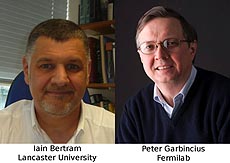 |
| Iain Bertram was the primary analyzer for this measurement. Peter Garbincius also made an important contribution in his role as chairperson of the editorial board responsible for the internal review of the analysis and paper.
|
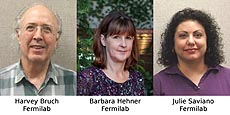 |
| The DZero administrative team provides a broad range of truly invaluable services to DZero collaborators, including everything from travel arrangements to battery recycling, from organizing social gatherings to fixing printer problems. We give special thanks to Julie Saviano, who is now transitioning to other projects, and welcome Barbara Hehner to the group.
|
|
|